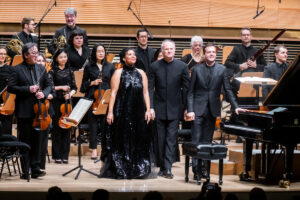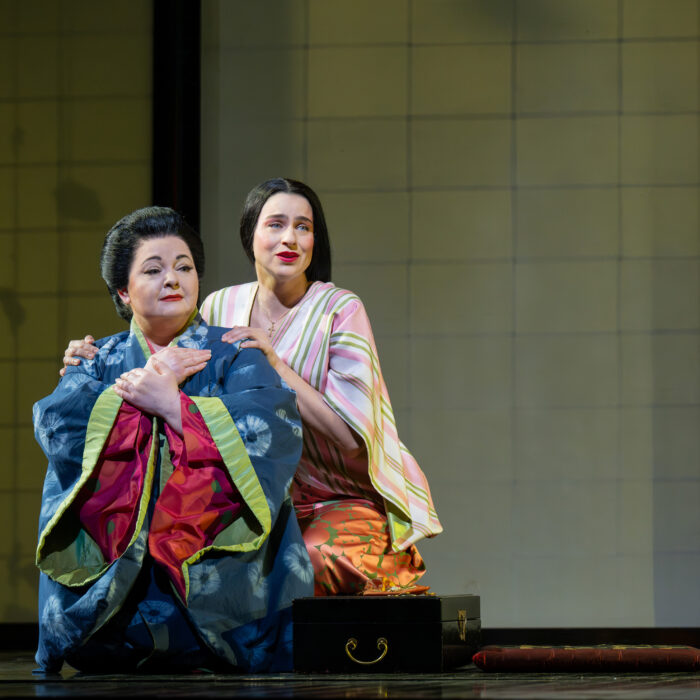
New York Philharmonic 2023-24 Review: Noseda Conducts Mahler & Mozart
Golda Scultz & Francesco Piemontesi Lead Delightful Evening
By Francisco Salazar( : Chris Lee Photographer)
: Chris Lee Photographer)
On Jan. 31, 2024, the New York Philharmonic performed an interesting program that included Mozart and Mahler, conducted by Gianandrea Noseda. The program focused on the joy of music, bringing together fine artistry from its orchestra and soloists.
On this evening Golda Schultz and Francesco Piemontesi were the evening’s guests and both had tremendous success on stage.
Mozart
The night began with Mozart’s concert aria “Ch’io scordi di te” which brought out both Piemontesi and Schultz to perform. The piece begins with a recitative which saw Schultz dig into her lush and round middle voice. However, as she had to go down to the lower parts of her voice in the lines “assai peggior!,” the voice lost some of its resonance.
But as she began the aria portion of the piece, Schultz’s voice flowed with a gorgeous legato line. The brightness of the middle register was on full display, especially as she held onto numerous phrases with precision. Her ascensions into the upper register were also delicate. especially as she repeated the first melody “Non temer, amato.” Here, Schultz added a couple of ornaments, sung with finesse and elegance.
In the Rondo portion “Alme Belle, che vedete,” Schultz sang with virtuosic power, holding out notes and singing with fierce and precise coloratura while still maintaining the elegance of her tone and Mozart’s music. Her coda section was an incredible display of the soprano’s flexibility as she moved forward with precise coloratura and ascended to her climatic high note with clarity.
At the piano Piemontesi, who was making his New York Philharmonic debut, played with delicacy as he blended his sound with Scultz’s bright sound. There were moments where he also combined with the orchestra in order to give Schutz center stage, creating the perfect balance for both to shine in the piece.
The second piece of the program was Mozart’s Piano Concert No. 25. Piemontesi performed each movement with precision and virtuosic nature. It was as if the pianist’s hands glided around the keyboard. The second movement, the Andante, was the highlight of the piece, as he blended beautifully into the orchestral playing as he accompanied and winds before returning to the solo line. There was also an elegance to each movement and the runs in the first and third movement were smooth and graceful. One could smile as Piemontesi played each line in Mozart’s piece.
Mahler
The second half was dedicated to Mahler’s Symphony No. 4. Noseda started the first movement “Bedächtig, nicht eilen” with a jovial sound to the orchestra that eventually led to a richer sound when the violins and cellos played their melodic lines. The second melody saw the winds give the piece a playful quality that they handed off to the strings. The waltz-like beat was also well-articulated and added to the flow of the piece.
The second movement, “In gemächlicher Bewegung, ohne Hast” saw the orchestra give the piece a mysterious sound that was contrasted by the first violinist’s jumpy solo. While the concertmaster’s sound took on a raspy tone, it was quite impressive how he resonated over the orchestra with ease. The brisk tempo gave for some unpredictable moments like the harsh accented notes, which were accompanied by the percussion.
Schultz returned to the stage during the third movement of the piece. She sat and listened as the orchestra played the gorgeous melodic lines of the “Ruhevoll, poco adagio.” You could see that she was enveloped in the music. Noseda for his part conducted this movement with ease as the cello line that opens the movement was delivered with lush sound, before being followed by the solo violin more delicate and ethereal sound. Meanwhile, the winds added texture to the violin playing. Toward the middle of the movement, there was an added playful quality to the winds and the violins that eventually built to a dramatic crescendo that showcased the immense sound of the New York Philharmonic. But as the movement concluded, Noseda brought back that calm ending with peacefulness and heavenly quality.
The fourth movement is almost like a lullaby. “Sehr behaglich” is described as sung “with childishly gay expression.” Schultz did just that as she sang with her bright sound and a joyful smile on her face. The rhythmic ascensions into the higher range flowed gorgeously and her lyrical legato lines were also beautiful. The lower notes did seem to stretch the soprano, but she compensated with her musicality. The orchestra also accompanied Schultz with the same propulsive and playful energy. During the “Kein’ Musik ist ja nicht auf Erden,” as the melody relaxed, Schultz leaned more into her legato phrases with a round tone. She extended the roulades with ease and, as she sang the last lines, her voice descended to a piano followed by the wind’s final iteration of the melody before also dying down to silence. It was as they say heavenly.


